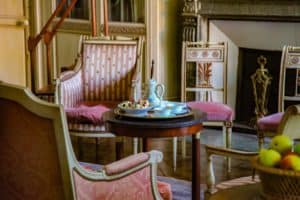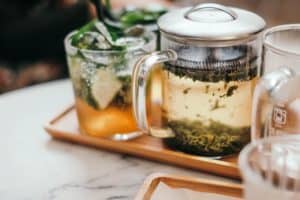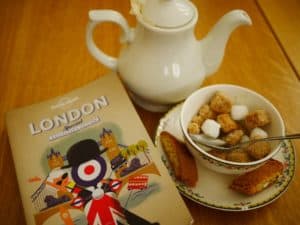Hey foodies, following up on our Best Tea Spots in London post, we’re exploring a bit deeper into the tea subject. Today, we’re exploring how tea rooms in London shape the city’s lifestyle. These charming spots are more than places to enjoy a cup of tea; these establishments are deeply integrated into London’s everyday life, affecting everything from how people socialize to the city’s artistic scene.
These tea rooms are much more than establishments for tea; they are lively, character-filled spaces where the essence of London’s culture is vividly on display. Each one offers a distinct and memorable experience.
In these tea havens, you’ll find a range of experiences – from the classic, serene environments that echo the city’s historical roots to the contemporary spaces that challenge the conventional tea-drinking experience. Each tea room tells its own story, reflecting the diverse neighborhoods and communities that make up the tapestry of London.
Tea Rooms in London: Origins and Early Development
Tea drinking in London, which began as an aristocratic practice in the 17th century, became a widespread phenomenon thanks to Catherine of Braganza. She introduced the custom, making tea a fashionable drink across all social classes as the British Empire expanded its trade routes. The first public tea rooms emerged in the mid-19th century, influenced by the temperance movement. These establishments offered an alternative to pubs, serving hot tea, light meals, and pastries. They became a foundation for the afternoon tea tradition, a custom popularized by Anna, Duchess of Bedford. She began the tradition of a mid-afternoon tea break, which soon evolved into a widespread social event.
Tea Rooms in London as Social Hubs and Cultural Centers
The establishment of the first chain of tea rooms in London by the Aerated Bread Company marked a significant development in the 1860s. These tea rooms were strategically located, elegantly decorated, and provided a respectable space for unaccompanied women, gaining popularity among the city’s middle-class women. By the late 19th and early 20th centuries, tea rooms had become more than just places to enjoy tea; they were also centers of art and design, reflecting contemporary artistic movements.
Tea Rooms Through the Wars and Beyond
During the World Wars, tea rooms in London took on a new role. They became essential communal spaces offering comfort and a semblance of normalcy. Post-war, they continued to thrive as venues for various social and political groups. Despite the rise of coffee culture and fast food, the tradition of afternoon tea has persisted. Today, iconic establishments and contemporary tea rooms attract both locals and tourists, offering both traditional experiences and modern interpretations.
Tea Rooms and Women’s Liberation
In the early 20th century, tea rooms played a crucial role in the women’s liberation movement, offering a space where suffragettes could meet and strategize. The Lyons tearoom, opened in 1894, and other similar establishments across London became vital meeting points for women advocating for suffrage and social change.
In summary, tea rooms in London are more than just venues for enjoying tea. They have been historical institutions reflecting the city’s social and cultural shifts over time, from spaces of temperance to symbols of sophistication and resilience.

The Culture of Tea in London
Tea in London has evolved from an elite indulgence to a daily staple, deeply ingrained in the social fabric of the city. Introduced in the early 17th century, tea was initially a luxury reserved for the wealthy, with prices so steep it was beyond the reach of the average citizen. However, its popularity rapidly grew, especially after Queen Catherine of Braganza made it fashionable in the royal court. By the mid-18th century, tea had become a common feature in London’s social scene.
Social and Economic Transformation through Tea
The popularity of tea led to significant social and economic changes. Expensive tea taxes in the 18th century, reaching as high as 119%, spurred widespread smuggling and adulteration of tea. However, the reduction of the tea tariff in 1784 brought an end to the black market and made tea more accessible. The expansion of trade routes by the East India Company also played a crucial role in reducing tea prices, making it affordable for the lower classes. By the 1800s, tea rooms and cafes were flourishing in London, serving as alternatives to alcohol for those who abstained.
Tea as a Social Ritual and Global Connector
In British culture, tea is much more than a beverage; it’s a social ritual. It’s common for meaningful interactions to occur over a cup of tea, and remembering someone’s tea preferences is seen as a gesture of care. The act of sharing tea has not only shaped social customs within the UK but also played a role in international relations, symbolizing hospitality and cultural exchange. The tradition of afternoon tea, popularized by the Duchess of Bedford in the 19th century, adds another layer to this ritual, combining tea with light snacks as a daily social event.
This narrative illustrates how tea has shaped London’s cultural and social landscape, from its early days as a luxury item to its current status as a ubiquitous and unifying element of daily life.

Tea Rooms and the London Lifestyle
Tea rooms in London have transcended their role as establishments for enjoying tea. They’ve become a part of the daily lifestyle, offering a space for relaxation, socialization, and even business meetings. This shift can be traced back to their origins in the Victorian era when they emerged as wholesome alternatives to pubs and taverns. Over time, these tea rooms evolved into sophisticated social spaces, becoming integral to the city’s social fabric. The Aerated Bread Company, for example, played a pivotal role in proliferating tea rooms in London during the 1860s, particularly among middle-class women for whom these spaces provided a respectable place for socializing or enjoying a quiet moment outside the home without male escort.
Tea Rooms as Social and Artistic Hubs
By the late 19th and early 20th centuries, tea rooms had become epicenters of art and design, showcasing movements like Arts and Crafts and Art Nouveau. Their significance further evolved during the World Wars, where they served as important gathering places, offering comfort and normality. In contemporary times, despite the emergence of coffee culture and fast food, the tradition of afternoon tea persists. Iconic establishments like The Ritz, Claridge’s, and Fortnum & Mason continue to uphold the legacy of traditional tea rooms, while contemporary spaces appeal to a younger, more diverse clientele.
Modern Afternoon Tea and Its Variations
The concept of afternoon tea has seen innovative adaptations in modern times, blending tradition with contemporary sensibilities. In London, you can find a wide array of afternoon tea experiences, ranging from traditional setups in luxury hotels to more unique and themed variations. For instance, the Mad Hatter’s Tea Party at Sanderson Restaurant offers an experience inspired by Lewis Carroll’s classic tales, while the Cookery School teaches how to prepare a traditional afternoon tea. Additionally, venues like City Cruises combine afternoon tea with a tour along the Thames, offering a unique way to enjoy this beloved tradition. Other noteworthy experiences include the Victorian Afternoon Tea at the Victoria and Albert Museum, offering a historical perspective, or the Potion Room Afternoon Tea inspired by Harry Potter. These diverse offerings turn the cultural habit of tea drinking into a delightful and engaging event.
Tea Rooms as a Reflection of London’s Diverse Culture
Today’s tea rooms in London are not only about serving tea but also about offering a cultural experience. They reflect the city’s rich history and its evolving cultural landscape. From traditional British settings to cross-cultural themes, tea rooms cater to a wide range of tastes and preferences, making them a significant part of London’s lifestyle. They serve as meeting points, spaces for relaxation, and venues for cultural exchange, highlighting the versatility and enduring appeal of tea rooms in the city’s daily life.
Through these aspects, tea rooms in London have profoundly influenced the lifestyle of Londoners, from leisure activities to social gatherings and business interactions. They represent the city’s ability to preserve its traditions while embracing modernity and diversity.

As we wrap up our exploration through Tea Rooms in London, it’s clear that these spaces are much more than just places to enjoy a brew. They are a vital part of London’s lifestyle, reflecting its history, culture, and ever-evolving lifestyle. Tea rooms in London offer a unique experience that intertwines tradition with modernity, making them enduring symbols of the city’s social and cultural fabric.
To fully immerse yourself in the essence of London and its love for tea, we invite you to explore the city’s culinary delights with Secret Food Tours. Our tours offer a unique opportunity to delve into London’s diverse food scene, including its famous tea culture and explorations from SoHo, to Camden Market, London Bridge, the Indian district and more. Check out our tours page and book your adventure to experience the flavors and stories of London, from its iconic tea rooms to its vibrant food markets.
